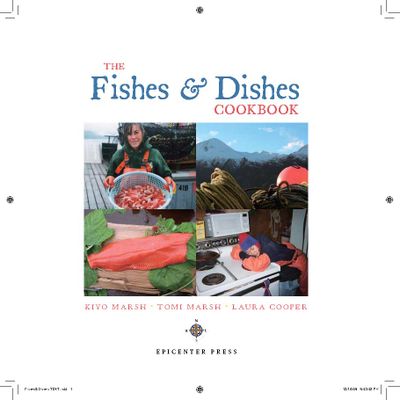Teach them How to Fish … . And then what?
Authors, fisherwomen to share writing, cooking secrets Friday

They went out looking for it. Hunted it down. Bagged it. Brought it back through many times perilous journeys. Prepared it. Cooked it. Served it up. Rejoiced in it. And, eventually, they wrote a book about it, with all the photos and illustrations and recipes and antidotal stories to pull even the most wary reader into their fold.
Don’t worry, this isn’t a story about Ted Nugent and Sarah Palin off on some romp in Alaska looking to shoot up an endangered ungulate and then ending up scribing some two-bit illustrated tell-all (in third grade prose).
We’re talking about three women who hit the seas crabbing, long-lining, gill netting in some violent waters in the Bering Sea and Southern Alaskan coordinates. Years of being around fishing and on oceans, and all the challenges, fun and spiritual expression that sort of life entails, have manifested into a really sparkling and simple book, called, “Fishes and Dishes Cookbook.”
Sisters Kiyo and Tomi Marsh and Laura Cooper, their friend and part-time deckhand, wrote stories and tips, illustrated sections, designed all the pages and tested recipes to be put into in this great fall read.
Kiyo and Laura will be in Spokane today at 5 p.m., as part of Sustainable September’s many events scheduled throughout the month. They expect to demonstrate how to de-bone a wild salmon, show slides, talk about life on the sea and answer questions, as well as sell books.
I talked with Kiyo and Laura on my radio show, “Tipping Points: Voices from the Edge” (www.kyrs.org; 92.3 FM) to get under the jacket cover of a really fine addition to the over-blown cookbook genre. There is a sense of whimsy throughout the edition, but it can be passionately poignant. It’s accented with poems, more than 80 recipes, useful and funny tips all bound up using a whole bunch of illustrations with plenty of photographs nicely placed throughout.
All three women have ocean cred, so to speak. The fact that more than a dozen women collaborated on the book, from writing, editing, adding poetry and just doing the nitty-gritty of putting a book like this together, attests to their conviction that fishing, ocean life, cooking and that on-the-shore perspective you get once you are back on land can be very different depending on which gender is describing the action.
It’s clear that Kiyo Marsh is the firebrand behind the publishing end of the book, even though she is still a chef and artist who ended up spending five years as a boat cook and deckhand on the F/V Savage.
That boat – the Savage — is her sister Tomi’s craft, and she has 27 years in the industry. Tomi lives in Ketchikan while her sister Kiyo is out of Poulsbo, Wash.
The third anchor in this trio spent time working for World Wildlife Fund International, as part of the global oceans and arctic programs. Laura Cooper lives in Seattle and is a collage artist.
Laura and I talked about the book, and about sustainability, the oceans reaching certain tipping points, the more or less well managed Alaska fisheries and the value of a book on food, celebrating the wild food she has caught and how women fit into what once was an exclusively male profession.
Laura believes that this book serves as a marker for young women, who can see that life on the sea – or just the value of traveling — and the sort of independence garnered writing a book with two others can be a reachable goal. She believes books serve as information guideposts and cultural memory banks.
For Kiyo, I gathered that she truly has respect and love of the craft of fishing, and the recipes she compiled are easily replicated, as Laura attested, since she admitted not having a huge culinary forte.
For the sisters, the book idea was tossed around many times, and the idea of cooking in the ditch (the trough of the wave) was played with for years. All those stories from other fishers, processors, captains, cooks, and from the entire retinue of actors in this drama were not wasted.
The photos are visceral, real, beautiful and informative; the stories genuine. The attempt to give landlubbers a sense of where wild protein comes from is detailed. Cooking marine fish and shellfish is easy, but each recipe takes on its own flavor, with all sorts of fusions blending with the flavors of Asia, Northern Europe and the Mediterranean as part of the final concoctions.
That sense of viewing the ocean, the food, the star-encrusted nights, the jostling crab nets, the solitary lifestyle, the woman against nature character of it all comes to the reader with a more refined and developed perspective than what a man might have given us — as these women share with us the art, science, luck and physicality of finding catch at sea.
Then turning that bounty into something magnificent like food. For Laura, sharing food – breaking bread, or, in this case, deboning fish – is the larger agenda for the book’s underpinning. It’s the sharing and the storytelling that make for healthy bodies, minds and communities.